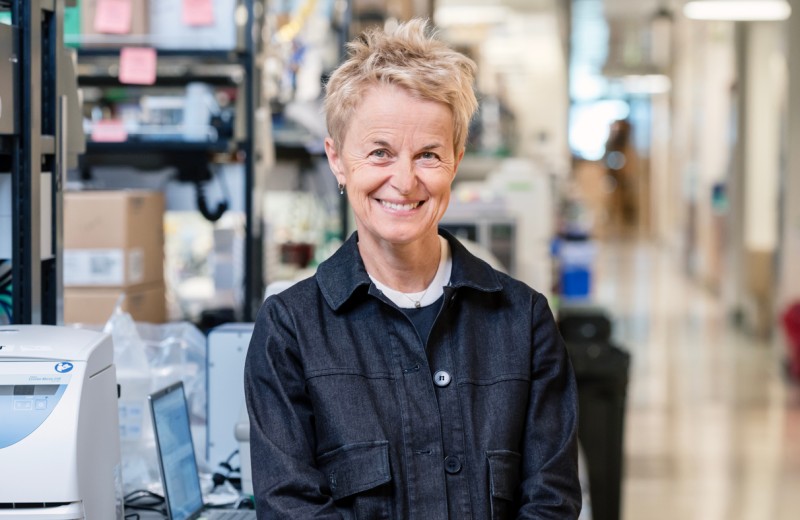Gladstone NOW: The Campaign Join Us on the Journey✕

SAN FRANCISCO, CA—Gladstone Institutes scientist Nevan Krogan, PhD, today is announcing research that identifies how HIV—the virus that causes AIDS—hijacks the body's own defenses to promote infection. This discovery could one day help curb the spread of the HIV/AIDS pandemic.
Dr. Krogan conducted this research in his laboratory at the University of California, San Francisco (UCSF)—a leading medical school with which Gladstone is affiliated—where Dr. Krogan is an associate professor of cellular and molecular pharmacology and an affiliate of the California Institute for Quantitative Biosciences (QB3). Since joining Gladstone as an associate investigator in June, Dr. Krogan has served as a unique, collaborative bridge between the two institutions in the field of systems biology, an area in which scientists perform advanced, computational analysis of large-scale data sets that are drawn from complex biological systems.
In his companion papers being published online today in Nature, Dr. Krogan describes how HIV commandeers restriction factors—a class of human proteins that have evolved to block viruses such as HIV—to weaken the body's defenses and enhance the virulence of HIV infection.
“One of the keys to HIV's success is how quickly it can evolve new attack strategies—and the way in which it uses our own proteins against us is a prime example of that,” said Dr. Krogan. “However, now that we've shed light on this complex process, we are one step closer to developing new drugs that will help us pull ahead in this evolutionary arms race.”
AIDS has killed more than 25 million people around the world since first being identified some 30 years ago. In the United States alone, more than one million people live with HIV/AIDS at an annual cost of $34 billion. Dr. Krogan's experiments show promise for the development of more effective antiretroviral therapies for people with HIV. Further, they have laid the foundation for future research at Gladstone.
In his experiments, Dr. Krogan performed a two-part investigation of protein interactions. First, he conducted a systematic, global analysis of all potential interactions that occur between proteins made by the body (human proteins) and proteins made by the virus (HIV proteins). Second, he whittled down these ~500 interactions to the one that appeared most likely to fuel HIV infection: the interaction between the human protein CBFβ and the HIV protein Vif.
Normally during HIV infection, a restriction factor called APOBEC3G acts as a molecular roadblock, preventing the virus from reaching its target—the CD4 T white blood cells that are a major component of the immune system. But Dr. Krogan found that when the HIV protein Vif binds to the human protein CBFβ, Vif is strengthened and APOBEC3G degrades. This degradation weakens ABOBEC3G's ability to stop HIV and the virus is free to infect the CD4 T cells.
“This is the first comprehensive look at how HIV interacts globally with components of the cell,” said Judith H. Greenberg, PhD, acting director of the National Institutes of Health's National Institute of General Medical Sciences, which partially supported this research through its AIDS-related structural biology program. “The work is a good example of how biophysical studies can improve our understanding of disease and point the way to the exploration of potential therapeutic targets.”
Other groups at UCSF who participated in this research include the labs of John Gross, PhD, Andrej Sali, PhD, Alan Frankel, PhD, Alma Burlingame, PhD, Charles Craik, PhD, Ryan Hernandez, PhD, and Tanja Kortemme. Funding came from a wide variety of sources, including QB3, the Host Pathogen Circuitry Center at UCSF, the Searle Scholars Program, the W.M. Keck Foundation and the National Institutes of Health.
Beyond Viruses: Expanding the Fight Against Infectious Diseases
Beyond Viruses: Expanding the Fight Against Infectious Diseases
The newly renamed Gladstone Infectious Disease Institute broadens its mission to address global health threats ranging from antibiotic resistance to infections that cause chronic diseases.
Institutional News News Release Cancer COVID-19 Hepatitis C HIV/AIDS Zika Virus Infectious DiseaseCharting the Body’s Defense Against HIV Leads to Broader Immune Revelations
Charting the Body’s Defense Against HIV Leads to Broader Immune Revelations
Gladstone scientists created a new tool to understand the immune system’s inner workings when confronted with a virus.
Research (Publication) HIV/AIDS Infectious Disease Roan LabThe Audacity of Hope: Stories of Resilience and Empowerment | World AIDS Day 2024
The Audacity of Hope: Stories of Resilience and Empowerment | World AIDS Day 2024
Rewatch The Audacity of Hope, a powerful webinar hosted in honor of World AIDS Day 2024.
HIV/AIDS Ott Lab



